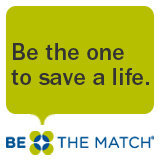 Save a life by signing up for the Be The Match Bone Marrow Registry.
Save a life by signing up for the Be The Match Bone Marrow Registry.
Only 30% of patients who have leukemia, lymphoma, or another disease that can be cured with a transplant find a match in their family. So most people look to Be The Match for help. Although they call this a “bone marrow transplant”, it is in fact blood stem cells that are collected from donors to infuse into a patient who has a disease or cancer of the blood or blood forming system. The patient’s bone marrow is destroyed using chemotherapy and/or radiation, and the healthy donor stem cells make their way into the patients marrow, replacing the diseased blood forming system with a healthy one.
The Be The Match Registry was started in 1987 and has now grown to more than 10.5 million donors, the largest and most racially and ethnically diverse registry of its kind in the world. Medical advances are making marrow and cell transplants available to more patients all the time. Since they began operations in 1987, Be The Match has facilitated more than 55,000 transplants to give patients a second chance at life. Today, they facilitate more than 5,800 transplants a year. Still, many patients never find their match, and are unable to benefit from this medically available treatment for their life-threatening disease.
Joining the registry is easy. Fill out the registration form and swab your cheeks with q-tips. If you show similarities to a patient who needs a transplant, Be The Match will call you to inform you of the next step, which is usually a blood sample to test at a definitive level. The only way to know if you can help is to get on the registry.
The Office of Spiritual Life and Service Learning is proud to host Be The Match at the Blood Drive from Noon – 4 pm on Wednesday, January 29, 2014. Be The Match will have a table outside the MTCC ballroom and will be signing people up for the registry.
Even if you’re not usually eligible to donate blood at one of our blood drives, you can still sign up for the bone marrow registry. People from all backgrounds are encouraged to sign up.
Because any patient’s best possibility of finding a match is within their own ethnic group, there is an especially great need for donors of full minority descent or anyone who is of mixed ethnicities.
Less then 30% of minority patients ever find a donor match. If you are of a smaller ethnic group, the odds are even lower then that. If you are from one of the following communities, you are urgently needed in the national registry to be a bone marrow donor, stem cell or cord blood donor:
Black and African American
American Indian and Alaska Native
Asian (for example: only 1.9% of registered donors are of South Asian descent, and only 1.1% are of Chinese descent)
Native Hawaiian and other Pacific Islander
Hispanic and Latino
Multiple race
